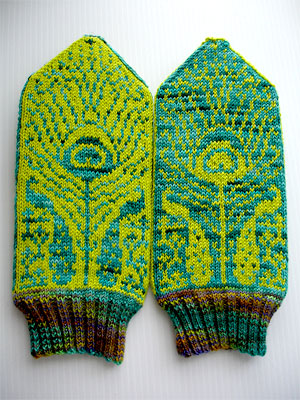Lesson Four: Colorwork
Sometimes one color of yarn is not enough. Sometimes you want stripes or nifty patterns or pretty pictures. That's when it's time to knit with multiple colors.
Note: Of the techniques covered in this class, multi-color knitting is the one I've the least amount of experience with. What I've written is a brief overview and a (very) few personal thoughts. However, I'm also including links to some really fine resources for each type. That should help you on your way, much better than I can.
There are several ways of kniting with more than one color (well, yarn, but let's keep calling it color), and it's possible that you've already done this. Knitting stripes, such as in a Hogwarts scarf, is perhaps the most simple way of using multiple colors. Usually stripes last for the whole row or round, making switching colors fairly straightforward and simple. Plus, you're only working with one color per row, so it's not particularly confusing.
Mosaic knitting

Photo by Girlontherocks on Flickr
Mosaic knitting also only works one color per row. In mosaic knitting, you switch yarn every row or two and only work some of the stitches in the new yarn; the others you slip.
Further reading:
Slip in Some Color by Kristi Porter
When you think about multi-yarn knitting, though, you're probably thinking of either stranded knitting (think ski jumpers) or intarsia (sweaters with pictures on them).
Stranded knitting

Photo by The Bees on Flickr
Stranded knitting is using two or more yarns across a row, often in smaller patterns. The most well-known type of stranded knitting is Fair Isle knitting. While some people will use these terms interchangeably, they're not, quite. Think of Fair Isle knitting as a particular brand and stranded knitting as the generic.
The thing to rememebr about stranded knitting — and I can't stress this enough — is to carry the yarn loosely across the back. I haven't done many stranded projects, but that's where I stumble. While my floats (the yarn that's stranded across the back) haven't generally been too tight, they're tighter than they should be; even when I think I'm carrying the yarn loosely, I'm not. But, like everything in knitting, it just takes some practice.
Further reading:
Techniques with Theresa: Color stranding by Theresa Vinson Stenersen
Fair Isle/Stranded Knitting by Sarah E. White
Fair Isle and Norwegian Knitting by Kathy
Intarsia knitting

Photo by craftastrophies on Flickr
Intarsia knitting is using different colors on a row, but they don't go all the way across. It's how you can have random circles or pictures in your knitting.
The key to intarsia knitting is to make sure the yarn at the color joins are linked together. If you don't twist the yarns around each other, you'll get holes in your work, and you don't want that. I would suggest not to twist the yarn too much; I've made that mistake before, and it just makes the joins stand out a bit more.
Intarsia feels very clumsy, in my limited experience. Because you've got all these strands of yarn hanging everywhere, it's easy to feel all thumbs. But keep pushing through; it only feels like it's not going to work. If you twist your joins well, there shouldn't be any trouble.
Further reading:
About Intarsia by KnitPicks
Intarsia Tutorial at The Purl Bee
Intarsia by Vicki Designs